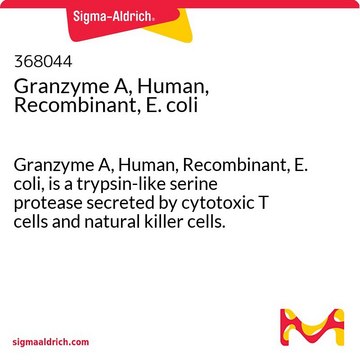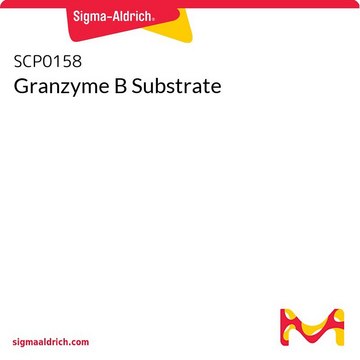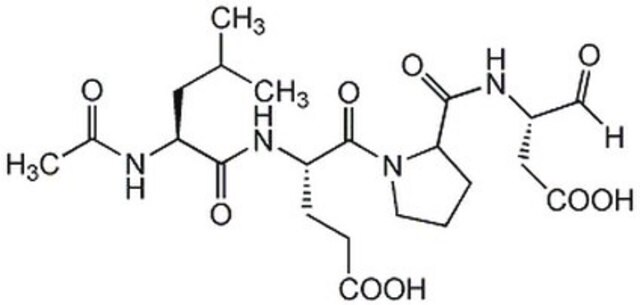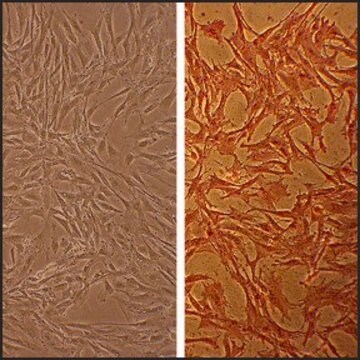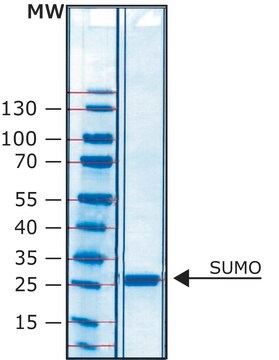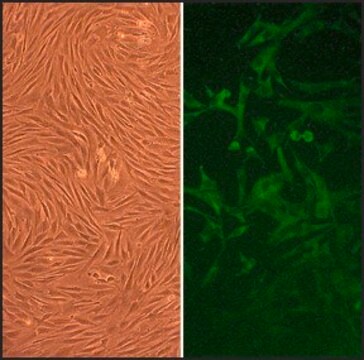SRP3202
Granzyme B from mouse
recombinant, expressed in Hi-5 Insect cells, ≥97% (SDS-PAGE), ≥97% (HPLC), suitable for cell culture
Zaloguj sięWyświetlanie cen organizacyjnych i kontraktowych
About This Item
Kod UNSPSC:
12352200
NACRES:
NA.32
Polecane produkty
pochodzenie biologiczne
mouse
rekombinowane
expressed in Hi-5 Insect cells
Próba
≥97% (HPLC)
≥97% (SDS-PAGE)
Postać
lyophilized
masa cząsteczkowa
28.9 kDa
opakowanie
pkg of 10 μg
metody
cell culture | mammalian: suitable
zanieczyszczenia
<0.1 EU/μg endotoxin, tested
kolor
white to off-white
numer dostępu UniProt
Warunki transportu
wet ice
temp. przechowywania
−20°C
informacje o genach
mouse ... GZMB(14939)
Opis ogólny
Granzyme B is a cysteine protease found in the cytoplasmic granules of cytolytic T lymphocytes (CTL) and natural killer (NK) cells. Granzyme B is required for the induction of target cell lysis, which occurs as part of cell mediated immune responses, and can activate apoptosis in target cells by both caspase dependent and caspase independent mechanisms. Proteolytic cleavage of substrates by Granzyme B takes place primarily after aspartic acid residues. Recombinant murine Granzyme B is a glycosylated 227 amino acid protein, comprising the mature active portion of the murine Granzyme B precursor. The apparent molecular weight is 28.9 kDa by mass spectrometry.
Działania biochem./fizjol.
Granzyme B is a cysteine protease found in the cytoplasmic granules of cytolytic T lymphocytes (CTL) and natural killer (NK) cells. Granzyme B is required for the induction of target cell lysis, which occurs as part of cell mediated immune responses, and can activate apoptosis in target cells by both caspase dependent and caspase independent mechanisms. Proteolytic cleavage of substrates by Granzyme B takes place primarily after aspartic acid residues. Recombinant murine Granzyme B is a glycosylated 227 amino acid protein, comprising the mature active portion of the murine Granzyme B precursor. The apparent molecular weight is 28.9 kDa by mass spectrometry.
Sekwencja
IIGGHEVKPH SRPYMALLSI KDQQPEAICG GFLIREDFVL TAAHCEGSII NVTLGAHNIK EQEKTQQVIP MVKCIPHPDY NPKTFSNDIM LLKLKSKAKR TRAVRPLNLP RRNVNVKPGD VCYVAGWGRM APMGKYSNTL QEVELTVQKD RECESYFKNR YNKTNQICAG DPKTKRASFR GDSGGPLVCK KVAAGIVSYG YKDGSPPRAF TKVSSFLSWI KKTMKSS
Postać fizyczna
Lyophilized from 1x PBS.
Rekonstytucja
Centrifuge the vial prior to opening. Reconstitute in water to a concentration of 0.1-1.0 mg/ml. Do not vortex. This solution can be stored at 2-8°C for up to 1 week. For extended storage, it is recommended to further dilute in a buffer containing a carrier protein (example 0.1% BSA) and store in working aliquots at -20°C to -80°C.
This page may contain text that has been machine translated.
Kod klasy składowania
11 - Combustible Solids
Klasa zagrożenia wodnego (WGK)
WGK 3
Temperatura zapłonu (°F)
Not applicable
Temperatura zapłonu (°C)
Not applicable
Certyfikaty analizy (CoA)
Poszukaj Certyfikaty analizy (CoA), wpisując numer partii/serii produktów. Numery serii i partii można znaleźć na etykiecie produktu po słowach „seria” lub „partia”.
Masz już ten produkt?
Dokumenty związane z niedawno zakupionymi produktami zostały zamieszczone w Bibliotece dokumentów.
Granzymes at a glance.
Michael Bots et al.
Journal of cell science, 119(Pt 24), 5011-5014 (2006-12-13)
Katherine M Horvath et al.
Respiratory research, 12, 102-102 (2011-08-06)
Modified function of immune cells in nasal secretions may play a role in the enhanced susceptibility to respiratory viruses that is seen in smokers. Innate immune cells in nasal secretions have largely been characterized by cellular differentials using morphologic criteria
Inka Albrecht et al.
The Journal of clinical investigation, 125(12), 4612-4624 (2015-11-10)
Mutations of the gene encoding four-and-a-half LIM domain 1 (FHL1) are the causative factor of several X-linked hereditary myopathies that are collectively termed FHL1-related myopathies. These disorders are characterized by severe muscle dysfunction and damage. Here, we have shown that
Nasz zespół naukowców ma doświadczenie we wszystkich obszarach badań, w tym w naukach przyrodniczych, materiałoznawstwie, syntezie chemicznej, chromatografii, analityce i wielu innych dziedzinach.
Skontaktuj się z zespołem ds. pomocy technicznej

